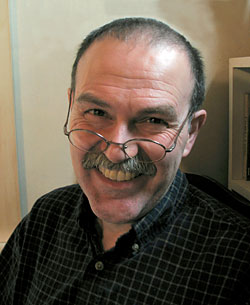Into the Woods
By Dave King | May 19, 2020 |
 Say that you’ve created a main character or two that you love and then start to follow their story. That story leads you to new characters you love every bit as much, and you delight in watching them start to interact with the main characters. Then the story takes an unexpected turn that you can’t resist, leading into new settings and new drama that absolutely excite you.
Say that you’ve created a main character or two that you love and then start to follow their story. That story leads you to new characters you love every bit as much, and you delight in watching them start to interact with the main characters. Then the story takes an unexpected turn that you can’t resist, leading into new settings and new drama that absolutely excite you.
And then you realize you haven’t written anything about your main character for sixty pages, and your story is now focused on a character your readers didn’t meet until 100 pages in. So you try to pull it all together into a single storyline, and the only way to do that is through some serious deus ex machina manipulation. Then you realize that following your story has led you right off into the middle of the woods.
If you look around and find yourself lost, how do you find the breadcrumbs to lead you back out?
The first step is understanding how you got there. Every writer approaches their novel differently, and there’s no such thing as a wrong approach. But if you are the kind of writer who prefers to launch into a story with no idea how it will end, then getting lost in the woods is an occupational hazard. I know because I’ve had several clients come to me to help them find their way home.
The answer is simple but not easy. The first step in finding your way home is to go back to the beginning of the novel, before you got led astray. Look closely at the first character who engaged your imagination. What was it about them that made you love them? Then ask yourself the classic plot questions. What does this character need? What do they want? Why can’t they get it? How will getting it change them? You might even have to force yourself out of your comfort zone and answer these questions in an outline before you start rewriting.
Because the next step would be rewriting. Once you’ve got these questions and that character firmly in mind, start from scratch. Save your old draft somewhere – you may want to strip it for parts later. But with your character and his or her needs firmly in front of you, start writing fresh from the beginning. If, as you write, new characters or situations try to intrude, go back to the main plot questions and focus. How does this new character help or prevent your main character from getting what they want? If you don’t have an answer, then resist the temptation to follow the new character. It’s hard, but it’s necessary.
There’s another reason why you might find your plot leading you off into the wilderness – you love your characters too much. Creating these people and the world they live in can be almost addictive, and after investing so much of your own heart and soul into these people, you may be unwilling to say goodbye to them. If you bring their story to an end, you can’t spend time with them any more. It’s literary empty-nest syndrome.
Once again, the only answer is simple and painful – you have to let go. But you can console yourself that you can meet these characters again in a sequel – revisiting beloved characters is one of the draws of writing a series. And if you have situations or settings that you love, well, writers are notorious recyclers. Look how John Irving managed to pull the better elements of his first novel, the rambling, disjointed Setting Free the Bears, into The World According to Garp.
In both cases, you need to learn to turn your creativity loose in order to enjoy the rush of writing. But you can’t let that urge run amok. When jazz musicians go into brilliant, spontaneous riffs, they still have the basic tonal structure and rhythm of the underlying piece in mind. Their creative instincts are leading the way, but they’ve still got a light hand on the reins.
You need to learn to hit the same balance – enough freedom to let your story surprise you from time to time or to follow an intriguing thread somewhere interesting, but not so much freedom that your story is buried under an excess of riches.
Years ago, I worked with a client who had exactly the problem I opened with, right down to the shift to a new cast of characters and the ridiculous deus ex machina ending. We worked together on that novel, her first, for months, but in the end she had to abandon it. Her second novel published. So has her third. She was able to get control of her creativity so that she was the one running the show.
The idea for this article came from suggestions WU members made on the WU Facebook page. So what would you like to see featured here? What writing problems are bothering you? If you’d like to keep your concerns private, or to ask a specific question about your WIP, you can contact me at the email address on my website.
[coffee]










This has happened to me. It took me a while to finally realize it. But when I did, I pulled the plug. I deleted 30,000+ words and started over. This week, I typed the end on that book, and I’m pleased with the new one (already contracted). The more I write, the more I realize it isn’t a bad thing to delete. I’ve got more words.
Love this, “I’ve got more words.” Yes!
Hugs
Dee
I’m with Denise. Nicely put, Ane.
Learning to leg to of a WIP is even harder when you have to let go because you love it too much.
I’m reworking a draft… and realizing I am going to have to let go of words! Great to have this encouragement!
Let go of words? Are you falling in love with the language rather than plots and character? That sort of thing?
Great post, Dave.
It’s hard to let go of a WIP that hasn’t progressed in the right direction. It is, however, necessary.
You’ve provided wonderful insight.
Yours,
Denise (Dee)
Thanks, Dee.
Unlike the Garrison Keillor shelf novel in last month’s column, these WIP’s are even harder to let go of because it’s excess love that is leading them astray.
Dave, thanks for sharing these insights. As a recovering pants-er, I have been guilty of falling into this trap. I am getting better at intentionally identifying the main character’s goal, needs, and oppositional forces and sticking to that as the story proceeds. It is so easy to go down rabbit holes by falling in love with ancillary characters, or plot strands that do not advance the main story. I find it helpful to focus on the main character’s goal and how that character will go through a transformative process on the way to achieving that goal. Thanks, again!
I’m with Denise. Nicely put.
And learning to back off and start again is one of the hardest lessons of writing.
It sounds as if there’s a story behind “recovering pantser.” You’ve run into this problem before?
I kind of wonder whether the distinction is not more between writers who fall in love with their characters and writers who are in love with the shape of the story. The latter are less likely to lose sight of the story while following their characters.
Dave, this observation is invaluable: “…writers who are in love with the shape of the story…are less likely to lose sight of the story while following their characters.” That’s practically a whole book on “how to write” compressed into one sentence. And for my WIP, narrative nonfiction, it is just as useful. I’m saving it.
Dave, I have to admit I loved the shape of the story in the finished manuscript, and lost sight of the story when I followed the main character –into her childhood. Your last suggestion to go over the manuscript again and apply what I’ve learned from the start– working with you as editor–stuck in my mind. Chapters that had nothing to do with the main character’s goals have been removed. Some of that history (backstory) in the beginning chapters, after the first, already had been included in dialogue in other chapters in older life. You had suggested to begin the story in the main character’s older life after the first chapter. I’m doing that, and will continue the story, another thread of the goal in the original manuscript, not in the planned sequel. Distance from the story gave me perspective where the story should go. Thanks so much for the Aha moment. 📚Christine
You’re quite welcome, Christine. And getting lost in a character’s history may be a specific subset of the problem I’m talking about. I’ve seen a lot of clients essentially publish their character research.
Dave, it seems as if I got stuck in the woods. And it slowed the story down. Fixing that is actually exciting & fun with new ideas. 📚🎶 Christine
I remember this happening once and I had to do a similar thing: delete like 20k.
The longer I go, the more I realize the reason King only needed 3 drafts is because they were *full drafts.* He’s not counting proofreading. He’s only counting typing the whole thing over. When you consider many of his are over 200k, it’s damned impressive that he types that much that often. Or R.L. Stein with his nubby finger.
In any case, thanks Dave. Really liked this one.
Let go of words? Are you falling in love with the language rather than plots and character? That sort of thing?
Or Noel “Hot Lead” Loomis. Loomis wrote shoot-em-up westerns and, I believe, novelizations of episodes of shows like “Gunsmoke” or “Bonanza.” And he wrote them directly on a linotype. When he finished a page, he had a complete printer’s plate for that page. Any revision had to be done with a blowtorch.
I hope you saved that 20K words somewhere. As I say, writers are recyclers, if not hoarders. You never know when an image or minor character might come in handy.
Wonderful stuff. I had to find this out the hard way, too. You’ve articulated it so well it seems obvious in hindsight!